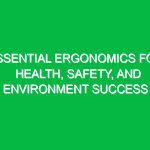Introduction
Hello, team! Today, we’re going to have an important toolbox talk focused on a fundamental principle in our Health, Safety, and Environment (HSE) practices: Take Ownership of Safety. This principle is not just a slogan; it is a mindset that each of us must adopt to ensure our work environment remains safe and healthy. As we prepare to start our tasks, let’s discuss how we can all actively participate in this ownership and the impact it has on our Safety culture.
Understanding Take Ownership of Safety
Take Ownership of Safety means recognizing that each individual is responsible for their own safety and the safety of their colleagues. It’s about being proactive rather than reactive. When we take ownership, we don’t just follow rules; we internalize them and make safety a personal commitment. This approach can significantly reduce the likelihood of accidents and injuries at work.
The Importance of Taking Ownership
Why is taking ownership so crucial? Consider this: when everyone on a team feels responsible for safety, it creates a culture where safety is prioritized. This culture leads to fewer accidents, less downtime, and a more productive work environment. Let’s explore some key Benefits:
- Improved Communication: When we take ownership, we communicate openly about safety concerns, which helps identify potential risks before they lead to incidents.
- Increased Accountability: Each member of the team holds themselves and each other accountable, fostering a sense of teamwork and collaboration.
- Enhanced Risk Awareness: A proactive mindset leads to better identification and mitigation of Hazards in our work processes.
- Empowered Employees: When employees feel empowered to speak up about safety, it creates a more engaged workforce.
Key Components of Taking Ownership of Safety
To effectively take ownership of safety, we need to understand and implement several key components:
1. Awareness of Hazards
Always be aware of your surroundings. Familiarize yourself with the potential hazards in your work area. This includes not just mechanical hazards, but also environmental risks, ergonomic concerns, and chemical exposures. For instance, if you notice a wet floor, take immediate action to report it or place a warning sign until it is cleaned up. This simple act contributes to the safety of everyone.
2. Reporting Unsafe Conditions
Do not hesitate to report unsafe conditions or behaviors. If you see something that doesn’t seem right, speak up! Reporting is not just a duty; it’s a critical part of taking ownership. For example, if you notice a colleague not wearing their Personal Protective Equipment (PPE), remind them gently or inform a supervisor. This is how we watch out for one another.
3. Participating in Safety Training
Engagement in safety training is vital. Training sessions are designed to equip you with the knowledge and skills necessary to perform your job safely. Take these sessions seriously and ask questions if something is unclear. Remember, safety protocols are there to protect you and your coworkers.
4. Leading by Example
As you take ownership of safety, remember that your actions set a precedent for others. Show your commitment by adhering to safety protocols diligently and encouraging others to do the same. For example, if you are always wearing your PPE correctly, others will be more likely to follow suit.
5. Continuous Improvement
Taking ownership also means striving for continuous improvement. Regularly evaluate your safety practices and look for ways to enhance them. This could be as simple as suggesting a safer tool for a task or proposing a new procedure to minimize risk. Always be open to learning from incidents or near misses and share those learnings with your team.
Real-Life Scenarios: Taking Ownership in Action
Let’s consider a couple of hypothetical scenarios that illustrate the concept of taking ownership of safety:
Scenario 1: The Slippery Floor
Imagine you are in the break room and notice that someone has spilled coffee on the floor. Instead of walking away, you take immediate action. You grab a towel to clean it up, or if it’s too much, you alert the janitorial staff. By doing so, you prevent someone from slipping and potentially getting injured. This is a clear example of taking ownership!
Scenario 2: The Missing PPE
During a site visit, you see a coworker working without their hard hat. Rather than ignoring it, you approach them and kindly remind them that Safety Gear is mandatory. If they resist, you inform your supervisor. This action not only protects your coworker but also reinforces the importance of safety Standards within the team.
Best Practices for Taking Ownership of Safety
Here are some actionable Best Practices to help you take ownership of safety every day:
- Conduct Daily Safety Checks: Before starting any task, take a moment to assess your work area for potential hazards.
- Use Safety Equipment Properly: Always use the required PPE for your tasks and ensure it is in good condition.
- Engage in Safety Meetings: Actively participate in safety meetings to discuss concerns and share ideas for improvement.
- Encourage Peer Support: Foster an environment where teammates feel comfortable reminding each other about safety protocols.
- Stay Informed: Keep up-to-date with the latest safety Regulations and company policies.
Addressing Potential Hazards
Part of taking ownership of safety is understanding the potential risks that come with our tasks. Here are some common hazards to be aware of:
Physical Hazards
These include anything that can cause physical harm, such as machinery, tools, or even the layout of your workspace. Always ensure that tools are maintained and that you are trained in their proper use.
Chemical Hazards
Working with chemicals requires knowing the safety data sheets (SDS) and understanding how to handle spills or exposures. Always wear appropriate PPE and ensure proper ventilation.
Ergonomic Hazards
Improper lifting techniques or awkward postures can lead to musculoskeletal injuries. Always use proper lifting techniques, and don’t hesitate to ask for help when lifting heavy objects.
Regulations and Standards
It’s essential to be aware of the regulations and standards that govern our work environment. The Occupational Safety and Health Administration (OSHA) provides guidelines that we must adhere to. Understanding these regulations not only helps us comply with legal obligations but also enhances our safety practices. Your commitment to safety directly impacts our compliance with these regulations, ensuring a safer environment for everyone.
Open Discussion
Before we conclude, I’d like to open the floor for discussion. What are some challenges you face when it comes to taking ownership of safety? Are there any experiences you’d like to share that illustrate the importance of this principle? Your input is valuable, and together, we can create a safer workplace.
Conclusion
In summary, taking ownership of safety is a critical element of our daily operations in the HSE domain. By being aware of hazards, reporting unsafe conditions, participating in training, leading by example, and striving for continuous improvement, we can foster a culture of safety that benefits everyone. Thank you for your attention today and for your commitment to maintaining a safe working environment. Remember, safety is everyone’s responsibility—let’s take ownership of it together!


